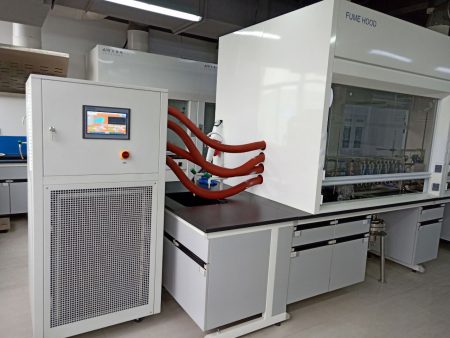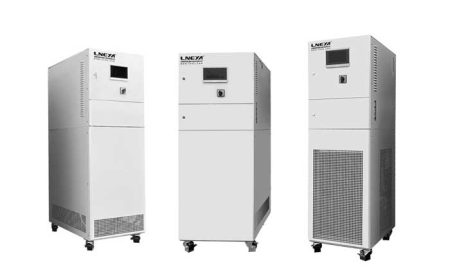Water Glycol Cooling System
完璧な温度制御ソリューションについては、今すぐお問い合わせください。
A water glycol cooling system is an industrial refrigeration system that uses an antifreeze called ethylene glycol mixed with water to lower the freezing point of the refrigeration system in the application.
Ethylene glycol is a class of organic compounds belonging to the alcohol family. When mixed with water and pumped through the pipes of a cooling system, ethylene glycol slows down freezing. It helps maintain temperature consistency across applications. Some glycol products can also inhibit corrosion and bacterial growth within cooling system piping.
Comparison of Two Ethylene Glycols
There are two varieties of ethylene glycol that should never be mixed together: ethylene glycol and propylene glycol. Both types offer the same relative frost protection rating. Both also help prevent corrosion. Certain grades of both types of glycol can also help prevent the growth of algae and bacteria inside the cooler.
Ethylene glycol
Ethylene glycol is a moderately toxic chemical that has a sweet taste and may be harmful if swallowed. Therefore, it should not be used in drinking water or food processing systems where leakage is possible. Ethylene glycol is more widely used due to its lower purchase price. Industrial applications such as skating rinks and factories that require large amounts of coolant find this to be the most economical option for ethylene glycol.
Propylene glycol
Propylene glycol is less toxic and is considered a food-grade antifreeze. This type of glycol is safer than ethylene and easier to handle. Propylene glycol is commonly used in the food industry or in industrial refrigeration systems where people may come into contact with liquids. Propylene glycol may also be more viscous than ethylene, slightly affecting heat exchange rates even when used at very low temperatures. It is important to note that you should never mix different types or brands of glycols as this can cause condensation of the product and clogging of filters in the refrigeration system, which can cause heat transfer and fluid flow problems.

Mixing water with ethylene glycol in industrial refrigeration systems
Ethylene glycol must be mixed with water to function properly. The type and amount of water to be used are key factors to consider.
Water type
Each glycol chiller has its own set of manufacturer recommendations for the best type of water to use with the system. Although tap water is initially acceptable, long-term use of deionized water is rarely recommended as it may adversely affect certain metals in the cooler. Sometimes manufacturers require coolers to use distilled or reverse osmosis water. The key is to check with the manufacturer about your refrigeration system’s specific needs.
The ratio of water to ethylene glycol
Calculating the appropriate ratio of glycol to water in a cooling system depends on the coldest temperature the glycol solution will reach during operation. If the cooling system is used indoors where there is no chance of freezing, the amount of glycol required will be significantly less than that required for a glycol chiller where outdoor temperatures tend to drop below freezing. Additionally, if the application requires very low temperatures to operate, a glycol mixture similar to that used in outdoor systems should be used. In cooling systems, this temperature is typically the saturated suction temperature in the evaporator, and this temperature is typically 10°F below the cooler set point temperature. It is important to use the proper ratio of glycol and water in your cooling system.
温度制御システムの設計から製造まで一貫して行います。標準モデルから完全なカスタマイズ製品まで 900 .私たちはカスタマーサービスに特化し、お客様一人ひとりのニーズに合った最適な温度制御システムを提供することに専念しています。
私達は標準外カスタマイズされた解決を提供します。単一の冷却のスリラーおよび冷却及び暖房のコンボの単位は両方利用できます。
Eメール info@lneya.com WeChat ID: +8615251628237 WhatsApp: +86 17851209193

循環式チラー / 冷凍サーキュレーター
(カスタムデザイン)
チラーは様々な産業や研究所で広く使用することができ、カスタマイズされた設計をサポートしています。
| 温度範囲 | -25°C ~ +30°Cシリーズ | -45°C ~ +30°Cシリーズ | -60°C ~ -20°Cシリーズ | -80°C ~ -20°Cシリーズ | -120°C ~ -70°Cシリーズ | ||||
| 冷却能力 | 0.8 ~ 30kW | 0.75 ~ 12kW | 0.4 ~ 6kW | 0.2 ~ 6kW | 0.3 ~ 5kW | ||||
| 注: -150℃の~ +350℃からの温度較差および冷却容量はカスタマイズすることができる | |||||||||
 ウォーター・チラー/小型チラー
ウォーター・チラー/小型チラー
(カスタムデザイン)
チラーは様々な産業や研究所で広く使用することができ、カスタマイズされた設計をサポートしています。
| 温度範囲 | -18°C ~ +30°C | +5°C ~ +35°Cシリーズ | |||||||
| 冷却能力 | 0.35 ~ 0.9kW | 1.8~50kW | |||||||
| 注: -150℃の~ +350℃からの温度較差および冷却容量はカスタマイズすることができる | |||||||||

低温チラー
(カスタムデザイン)
当社は、-150℃の温度制御範囲を持つ低温冷凍機の生産を専門としており、さまざまな業界の冷凍ニーズを満たすことができます。
| 温度範囲 | -25°C ~ -5°Cシリーズ | -45°C ~ -10°Cシリーズ | -60°C ~ -10°Cシリーズ | -80°C ~ -30°Cシリーズ | -110°C ~ -50°Cシリーズ | -150℃〜-110℃シリーズ | |||
| 冷却能力 | 12~360kW | 6~180kW | 6~180kW | 4〜180kW | 2~120kW | 2.5 ~ 11kW | |||
| 注: -150℃の~ +350℃からの温度較差および冷却容量はカスタマイズすることができる | |||||||||

高温チラー
(カスタムデザイン)
チラーは様々な産業や研究所で広く使用することができ、カスタマイズされた設計をサポートしています。
| 温度範囲 | +5°C ~ +40°C | -25°C ~ +40°C | -45°C ~ +40°C | -80°C ~ +80°C | -100°C ~ +80°C | ||||
| 冷却能力 | 6〜40kW | 2~15kW | 1~8kW | 0.6 ~ 3kW | 1.5~3kW | ||||
| 注: -150℃の~ +350℃からの温度較差および冷却容量はカスタマイズすることができる | |||||||||

冷暖房用チラー
(カスタムデザイン)
温度制御範囲:-120°C~+350°C
さまざまな企業で広く利用された冷却および暖房のサーモスタット。
| 温度範囲 | -10 ~ +150℃シリーズ | -25 ~ +200℃シリーズ | -25 ~ +300℃シリーズ | -45 ~ +250°C シリーズ | -45 ~ +300℃シリーズ | -60 ~ +250°C シリーズ | -60 ~ +300℃シリーズ | -70 ~ +250°C シリーズ | -80 ~ +250°C シリーズ | -90 ~ +250°C シリーズ | -100 ~ +100℃シリーズ | ||
| 冷却能力 | 1.5 ~ 15kW | 1~200kW | 1~200kW | 0.45~200kW | 0.9 ~ 25kW | 0.25 ~ 60kW | 0.75 ~ 25kW | 0.4 ~ 15kW | 0.3 ~ 80kW | 0.2 ~ 80kW | 0.45 ~ 80kW | ||
| 注: -150℃の~ +350℃からの温度較差および冷却容量はカスタマイズすることができる | |||||||||||||

循環式ヒーター・チラー
(カスタムデザイン)
温度制御範囲:-45℃~+250
| 温度範囲 | -25°C ~ +200°Cシリーズ | -45°C ~ +250°C シリーズ | |||||||
| 冷却能力 | 1 ~ 15kW | 0.25 ~ 15kW | |||||||
| 注: -150℃の~ +350℃からの温度較差および冷却容量はカスタマイズすることができる | |||||||||
 LNEYA
LNEYA
 简体中文
简体中文


















































































